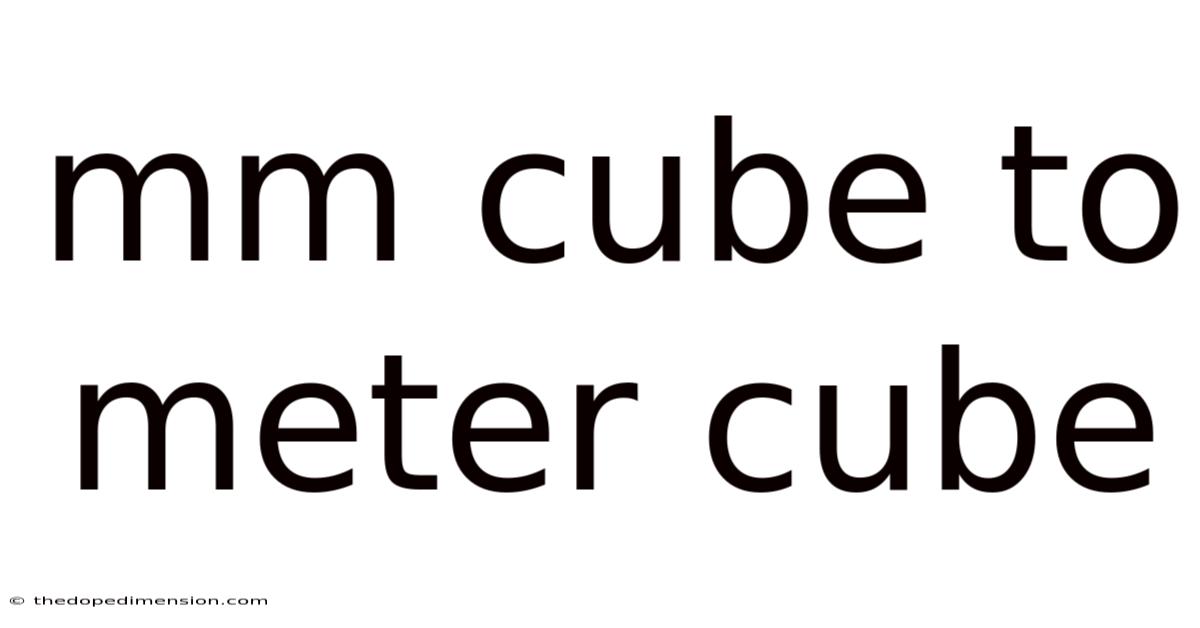Mm Cube To Meter Cube
thedopedimension
Aug 26, 2025 · 5 min read

Table of Contents
Mastering the Conversion: mm³ to m³
Understanding how to convert cubic millimeters (mm³) to cubic meters (m³) is a fundamental skill in various fields, from engineering and architecture to physics and chemistry. This comprehensive guide will walk you through the process, explaining the underlying principles, providing practical examples, and addressing common questions. Whether you're a student tackling a complex problem or a professional needing precise calculations, this article will equip you with the knowledge and confidence to master this essential conversion. We'll explore the conversion factor, delve into the mathematical reasoning, and offer practical tips to ensure accuracy.
Understanding Cubic Units
Before diving into the conversion, let's solidify our understanding of cubic units. A cubic unit represents the volume of a cube with sides of a specific length. For instance:
- Cubic millimeter (mm³): A cube with sides of 1 millimeter each. It's a very small unit, often used for measuring the volume of tiny objects or substances.
- Cubic meter (m³): A cube with sides of 1 meter each. It's a much larger unit, frequently used for measuring the volume of rooms, buildings, or large quantities of materials.
The Conversion Factor: From Millimeters to Meters
The key to converting mm³ to m³ lies in understanding the relationship between millimeters and meters. There are 1000 millimeters in 1 meter (1 m = 1000 mm). However, because we're dealing with volume (three-dimensional space), we need to cube this relationship.
Therefore, the conversion factor is:
(1 m)³ = (1000 mm)³ => 1 m³ = 1,000,000,000 mm³
This means that one cubic meter contains one billion cubic millimeters. This large number highlights the significant difference in scale between these two units.
Step-by-Step Conversion: mm³ to m³
Converting cubic millimeters to cubic meters is a straightforward process, requiring only one simple calculation:
1. Divide the value in mm³ by 1,000,000,000
Let's illustrate this with some examples:
Example 1: Convert 500,000 mm³ to m³
500,000 mm³ / 1,000,000,000 mm³/m³ = 0.0005 m³
Example 2: Convert 2,500,000,000 mm³ to m³
2,500,000,000 mm³ / 1,000,000,000 mm³/m³ = 2.5 m³
Example 3: Convert 15,000 mm³ to m³
15,000 mm³ / 1,000,000,000 mm³/m³ = 0.000015 m³
Scientific Notation and Simplification
For very large or very small numbers, using scientific notation can simplify the conversion process and improve readability. Scientific notation expresses numbers in the form a x 10<sup>b</sup>, where 'a' is a number between 1 and 10, and 'b' is an integer exponent.
For example, let's convert 8,750,000,000 mm³ to m³ using scientific notation:
- Express 8,750,000,000 in scientific notation: 8.75 x 10<sup>9</sup> mm³
- Divide by 1 x 10<sup>9</sup> mm³/m³ (this is the conversion factor in scientific notation)
- The result is 8.75 m³
This method is particularly useful when dealing with extremely large or small volumes.
Practical Applications: Real-World Examples
The conversion from mm³ to m³ is crucial in various practical scenarios:
- Engineering: Calculating the volume of materials needed for construction projects, determining the capacity of tanks or containers, and analyzing the dimensions of components.
- Architecture: Designing spaces, estimating material quantities, and ensuring compliance with building regulations.
- Medicine: Measuring the volume of medications, calculating dosages, and analyzing the size of biological samples.
- Physics and Chemistry: Performing experiments involving volume measurements, calculating densities, and understanding the properties of matter.
Common Mistakes and How to Avoid Them
One common mistake is forgetting to cube the conversion factor between millimeters and meters. Since we're dealing with volume (a three-dimensional quantity), we must cube the linear conversion (1000 mm/m). Simply multiplying by 1000 is incorrect.
Another potential error involves incorrect placement of the decimal point when performing the division. Carefully review your calculations and use a calculator to minimize errors.
Frequently Asked Questions (FAQ)
Q1: Can I convert from m³ to mm³ using the same principle?
A1: Absolutely! To convert from m³ to mm³, you would multiply the value in m³ by 1,000,000,000.
Q2: What if I have a value in cm³ (cubic centimeters)? How can I convert that to m³?
A2: There are 100 centimeters in 1 meter (1 m = 100 cm). Therefore, 1 m³ = 1,000,000 cm³. To convert cm³ to m³, divide the value in cm³ by 1,000,000.
Q3: Are there online calculators for this conversion?
A3: Yes, many online converters are available that can perform this conversion quickly and easily. However, understanding the underlying principles is crucial for accuracy and problem-solving.
Q4: What if my measurements aren't perfectly cubic?
A4: The principles remain the same, even for irregularly shaped objects. You would need to calculate the volume of the object using appropriate formulas (e.g., for spheres, cylinders, or irregular shapes using integration techniques) before converting the volume from mm³ to m³.
Conclusion: Mastering mm³ to m³ Conversions
Converting cubic millimeters to cubic meters is a fundamental skill with broad applications across various disciplines. By understanding the conversion factor (1 m³ = 1,000,000,000 mm³), and following the step-by-step process outlined above, you can confidently perform these conversions accurately. Remember to always double-check your calculations and utilize scientific notation for very large or small numbers to enhance clarity and efficiency. Mastering this conversion not only improves your problem-solving abilities but also enhances your understanding of volume measurement and its significance in the world around us. This knowledge will serve you well in your academic pursuits and professional endeavors.
Latest Posts
Latest Posts
-
Convert 35 Centimeters To Inches
Aug 26, 2025
-
What Is 15ml In Teaspoons
Aug 26, 2025
-
Convert Mg To Oz Calculator
Aug 26, 2025
-
Convert Ml To Pints Calculator
Aug 26, 2025
-
80 Cm By 80 Cm
Aug 26, 2025
Related Post
Thank you for visiting our website which covers about Mm Cube To Meter Cube . We hope the information provided has been useful to you. Feel free to contact us if you have any questions or need further assistance. See you next time and don't miss to bookmark.